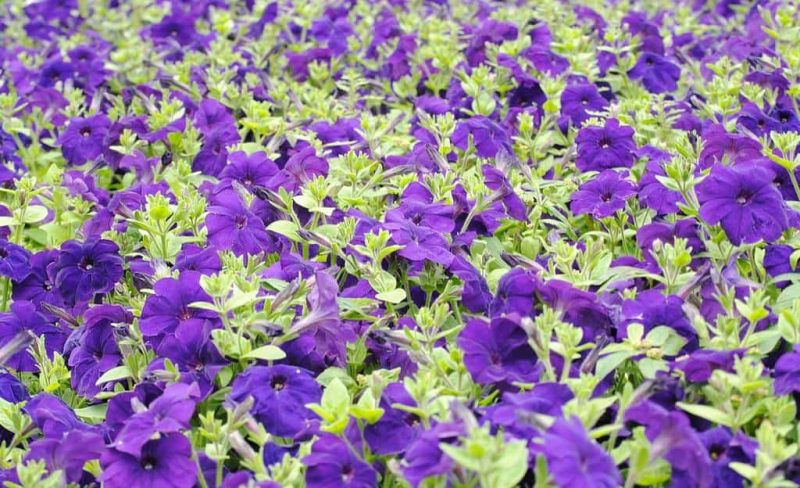You can learn how to trim petunias easily, but it’s crucial to know what to consider, when to trim petunias, and why we should trim petunias. Trimming, removing faded flowers, or deadheading are practices that should keep your plants healthy and blooming beautifully. However, this doesn’t mean that your plants will require heavy maintenance; remember that some petunias are self-cleaning as well.
You can also grow petunias in the greenhouse for added ease in maintenance. Compared to having petunias outdoors, you can keep them in a stable environment and avoid potential problems. More so, gardeners can find it more convenient to trim petunias in a greenhouse because it’s easier to monitor the plants indoors.

How To Trim Petunias: Three Questions To Ask
The trimming procedure of petunias is straightforward. You will cut back the tips two inches above the leaf sets at planting time. You can also pinch the tips by hand, and this will have the same result, which is encouraging the branching of the plants.
But besides during planting time, pruning and pinching petunias are also feasible once a month while making sure to leave a set or two of leaves. Some gardeners cut ⅕ of the total length of stems as a maintenance practice because petunias can be prone to becoming leggy and having trouble in growing. When you cut these leggy and unproductive stems, you can help your plants focus their energy on creating new growth.
According to the University of Vermont, you must also remember that some varieties don’t require cutting back to rebloom. The newer smaller petunias in the market can drop their own flowers, so you don’t need to deadhead them to continue blooming. On the other hand, the larger and double types of petunias will require deadheading for extended blooming and aesthetic purposes.
Question #1. What to consider when trimming petunias?
As mentioned earlier, you must check the variety you have if it will need pruning. Generally, smaller petunias don’t require trimming compared to larger plants. This is why spreading petunias won’t require pruning because you intend to have them over the landscape or spill on planters, but mounding and Grandiflora varieties need trimming to look better and thrive.
However, you may find that your plant will benefit more if you prune leggy and overgrown stems regardless of the variety. As with any other plant, letting them overgrow will not only look bad visually, but it also makes flower production unsatisfactory. You’ll notice that with pruning and deadheading, your petunias will be more productive.
Question #2. When to trim petunias?
In general, you can pinch at planting time to help encourage growth, and pruning itself is feasible in the middle of summer. This way, you don’t remove any potential new blooms. But what is the difference between minor and drastic pruning?
Intensive pruning is necessary if you notice your plants having trouble blooming, especially during the growing season. On the other hand, minor pruning is an option for the gardener once the plant is established. You’ll gauge if your plants need pruning or pinching, whether it’s to help with flower production or to retain a compact shape.
Intensive pruning can be the removal of two-thirds from the leggy stems and repeating it after a week. You’ll check if the plant is producing new blooms after trimming and if it grows more stem and leaves. Some gardeners also cut back late in the growing season, but keep in mind to leave some new growth on the branches.
Question #3. Why trim petunias?
Trimming petunias is a useful solution for plants that are being unproductive. More so, it helps in keeping petunias healthy and looking bushy. You will also need to deadhead some varieties because they can’t drop the faded flowers on their own.
Most gardeners trim petunias as soon as they plant them to encourage blooming. It doesn’t have to be intensive yet, as removing some stems weekly is practical. Clipping half of at least four stems of new petunias will encourage flowering.
Maintenance Tips For Petunias
Besides pruning and deadheading, another good practice to prevent petunias from being unproductive or developing leggy growth is keeping them well-watered. More so, the ideal environment for them plays a significant role in their overall health. This includes proper lighting, spacing, temperatures, and regular checkup for potential diseases.
For feeding, a balanced fertilizer would work well for petunias. Depending on the variety, your plants may want to feed weekly or use a time-release fertilizer. The main takeaway here is always checking the specific petunia variety or cultivar you have and adjusting your practices to its needs.
Conclusion
With the many varieties of petunias, you’ll indeed find the perfect fit for your garden. But to keep them looking their best and stay healthy, you must learn how to trim petunias. The good news is there are no plant-specific practices for petunias.
Some varieties can even clean themselves. However, cutting leggy and unproductive branches, removing faded flowers, and pinching is not just beneficial for aesthetics. They also help your plant produce more flowers and stay healthy.
In general, you can pinch and prune petunias once a month. However, the emphasis is necessary for understanding the three questions first. Identify what to consider, when to trim, and why trim petunias to create the ideal trimming practice for your plants.
